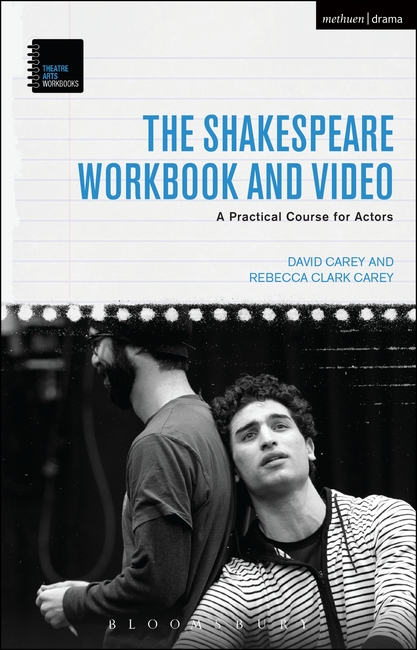Reviews
‘An intensely practical and inspiring teaching manual about the skills needed to perform Shakespeare.’ Greg Doran, Artistic Director, Royal Shakespeare Company
‘The Shakespeare Workbook and Video is a superb compendium of deeply intelligent, spirited, and practical approaches to the repertoire. The authors are expert and wise practitioners: the muscularity of their offerings, and their capacious contemporary sensibility, will make this book an invaluable tool for actor training in the 21st century.’ James Bundy, Dean, Yale School of Drama, and Artistic Director, Yale Repertory Theatre
‘The Careys’ approach to speaking Classical text is rigorous, precise, and visceral; all the necessary tools to bring Shakespeare from page to stage.’ Tarell McCraney, Actor, Academy Award Winning Playwright
‘When I think of my time at RADA, the Careys spring to mind immediately. What I learnt from David and Rebecca was invaluable; it was their techniques that most effectively conveyed to me the relationship between text, mind, breath and voice. These techniques are particularly useful when dealing with Shakespeare; their shared ability to demystify it is uncanny.’ Taron Egerton, Golden Globe Winning Actor
‘Rebecca and David teach invaluable ways to sift through the different clues in Shakespeare’s poetry and ask the most productive questions. Their coaching has helped me turn prep time into the practice of getting out of the text’s way, so that performance becomes the joy of riding language.’ Raffi Barsoumian, Actor
Contents
The Shakespeare Workbook and Video provides a unifying approach to acting Shakespeare that is immediately applicable in the rehearsal room or classroom. It is an easy-to-use text providing practical exercises in specific aspects of Shakespeare’s language such as meter, imagery, rhetoric and sound play. In each of these areas, it takes the reader through three steps: Speak the Text, Question the Text and Act the Text. Online video material provides an insight into the acting process and shows the authors teaching a workshop in their method for acting Shakespeare to a group of young actors.
Chapter 1 – Language as Action. This chapter focuses on using Shakespeare’s language actively by finding and pursuing the intentions that are embedded in the text. There are sections of exercises that explore ‘Having an Effect’, ‘Negotiating Complications’ and ‘Solving Problems’. These will help the reader move from impulse to action, building performances that are fresh, specific and illuminating of text, story and character. It also investigates how this process applies in soliloquies, when the actor is alone onstage.
Chapter 2 – Language in Action: Imagery, Sound and Story, Much of the poetry and power that is so admired in Shakespeare’s language is to be found in his vivid and original imagery and use of sound patterns such as alliteration and rhyme. To be dramatically effective, however, these devices must not be merely appreciated or analyzed but used actively by the performer to further the character’s intentions. This chapter will help the reader identify these devices and bring their dramatic potential to life, with a particular focus on storytelling. Exercise sections explore ‘Picture Painting’, ‘Ear Catching’ and ‘Storytelling’.
Chapter 3 – Rhythm and Metre. This chapter introduces the reader to the basic principles of metre in Shakespearean verse and explores how variations on the rhythm in both verse and prose can reveal shifts of thought and feeling and bring energy and variety to the playing of the text. These issues are addressed in exercise sections ‘Finding the Rhythm’, ‘Mastering the Rhythm’ and ‘Breaking the Rhythm.
Chapter 4 – Rhetoric and Style. Here the focus is on how rhetorical devices such as lists, repetition and antitheses relate to intention and action and can be used by the actor to shape a speech or scene and drive towards the character’s objective. The chapter also looks at the importance of considering the stylistic choices made by the character. The exercise sections are ‘Recognizing Rhetoric’, ‘Comedy and Style’ and ‘Complicated Characters’.
Chapter 5 – Preparation for Performance. This chapter introduces readers to some of the considerations that come into play when actors rehearse Shakespeare plays for performance. It is structured differently from the preceding chapters in that the exercises are not designed to help the reader find a process for developing a particular piece of text. Rather, they allow readers to take a piece they have already worked on and explore how they might adapt it to different performance demands and character circumstances. We conclude with an examination of some of the considerations involved in choosing an accent for a character.
Relevant appendices include a vocal and physical warm up, author biographies, sample curricula, a resources list and an extensive bibliography.

